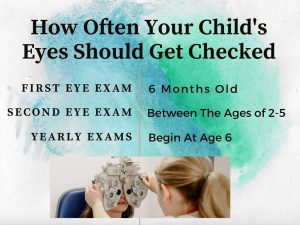As children grow, their eyes go through a lot of changes, including a lot of growth and development. In fact, their eyes will grow rapidly after birth and then will continue to grow during puberty until age 20 or 21. At this point, they will stop growing in size but will continue to increase in weight, as well as undergo age-related changes.
It is important to pay careful attention to your children’s eyes as they grow so you can catch any problems that might arise, and deal with them immediately. August is Children’s Eye Health and Safety Month, so to raise awareness this month, we have 12 things you need to know about children’s eyes and vision. 
- Smoking can harm an unborn baby’s eyes; in addition, if a baby is born premature, as many babies born to smokers are, they are more likely to have permanent vision loss or even blindness.
- By 3 months old, babies’ eyes should focus and follow objects; by 5 months old, babies are seeing in three dimensions and developing perception.
- At around 9 months old, a baby’s eyes have nearly turned their finalized color.
- Strabismus, also known as hypertropia and crossed eyes, occurs in around 4% of children in the US. This condition is a misalignment of the eyes, which causes one eye to deviate inward (esotropia) toward the nose, or outward (exotropia), while the other eye remains focused. If you suspect your child has this condition, seek evaluation so it can be corrected.
- Young children are more likely than adults to get eye damage from chemical burns, because these burns can permanently damage the external and internal eye structures as they are developing. That means there are multiple reasons why it’s important to make sure that children don’t have access to any cleaning products or chemicals. If an accident does happen, flush their eyes with plenty of water and go to the nearest emergency room.

- Looking at a TV screen or tablet too much can cause myopia (nearsightedness), and digital eye strain. In order to prevent myopia, it is important to have your children follow the 20-20-20 rule: make sure they look up from the screen every 20 minutes and focus at least twenty feet away for at least 20 seconds.
- There are some more subtle signs of childhood vision problems you should be aware of, including loss of interest in activities that they used to enjoy, losing their place when reading, and turning their head to look at something in front of them.
- Many people think that only older adults get cataracts, but children can get cataracts, too- they can either be born with them or develop them after birth.
- Taking photos of your children can help to diagnose certain eye problems. If you see what’s known as a “red reflex” on their eyes in a photo (a reflective phenomenon that creates a reddish-orange glow when light passes through the pupil and is reflected back off the retina to a viewing aperture) this is a warning sign that something might be wrong with your child’s eyes. Also, if there is a reflection of the camera flash off the retina that is white, yellow, or black in one or both eyes, this is also a sign that something is wrong.
- Color blindness is more common in boys than in girls, but it can be harder to detect. One of the signs to look out for is the inability to tell the difference between shades of the same or similar colors.
- Eye injuries are the most common cause of vision loss in children, and most often occur when they’re playing sports. Eye injuries can be prevented by having your child wear protective goggles when they are playing sports such as baseball, basketball, football, etc.
- Eyes can get sunburned just like skin can – a condition called photokeratitis – which causes pain, redness, and tears. Make sure your children (and you) wear sunglasses to protect their eyes from harmful UV rays.

It is very important to get your children’s eyes checked as recommended by The American Academy of Ophthalmology.
Getting Checked Regularly
Eye health is very important for your children, especially as they are physically developing, and learning in school. That’s why you should never skip their regular vision screenings; these screenings can help detect and correct any eye problems early before they get worse. The American Academy of Ophthalmology recommends vision screenings for children when they are in preschool and elementary school, as well as if they are experiencing any vision problems.
Taking your child to the eye doctor can help catch any conditions that your child’s pediatrician or school nurse cannot, but some health insurance plans don’t cover vision care – so if you are interested in a more comprehensive health insurance plan that does offer great vision care, EZ can help! Our agents work with the top-rated insurance companies in the country, and we can compare all available plans and find the best, most affordable plan for your family’s needs. To get free instant quotes, simply enter your zip code in the bar above, or to speak to a licensed agent, call 888-350-1890. No obligation!


